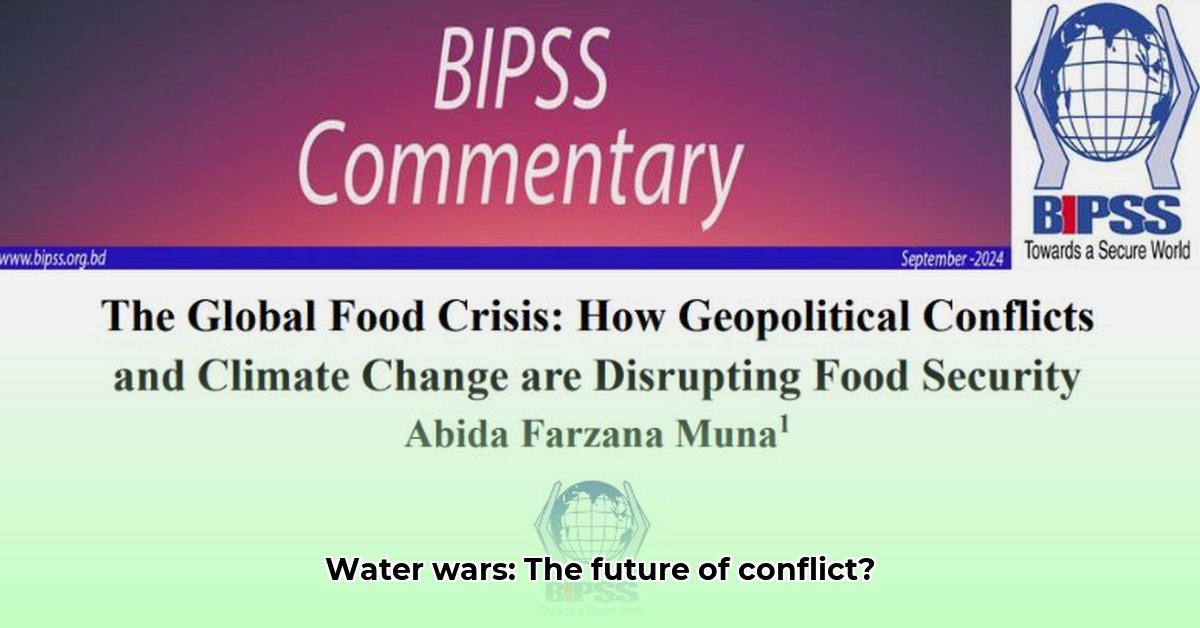Imagine a world where nations clash over access to water, not oil. Water scarcity is rapidly escalating geopolitical tensions, demanding immediate and comprehensive action. This article examines the nexus of water scarcity and global conflict, emphasizing data-driven insights to inform proactive solutions and build a sustainable water future.
The Geopolitics of Thirst: Understanding Future Water Conflicts
Water is emerging as a critical source of global tension, with the potential to ignite international conflicts. The confluence of a growing global population, accelerating climate change, and inefficient water management practices is creating an environment ripe for disputes over increasingly scarce water resources. How can we transform competition into cooperation and prevent future resource wars?
Evidence of a World Running Dry: Understanding Water Stress
From the parched landscapes of the Middle East to the drought-stricken regions of Africa, water stress is creating unprecedented global friction. The impacts of climate change, including more frequent and intense droughts and floods, are exacerbating existing vulnerabilities. While experts continue to debate the precise likelihood and scale of future “water wars,” the underlying threat is undeniably valid and demands our immediate attention. What proactive measures can be taken to better prepare for and mitigate future volatility?
Global Politics and Water: Key Players and Their Roles
Addressing this global challenge requires concerted collaboration from a diverse range of stakeholders. The United Nations (UN) plays a crucial role in coordinating international efforts and setting global standards. Individual nations must prioritize investments in water infrastructure and improved water management practices. Regional organizations serve as vital bridges between countries sharing water sources, fostering cooperation and resolving disputes. Individuals, non-governmental organizations (NGOs), and businesses developing and implementing water-efficient technologies all have a critical role to play. The complexity of this issue demands universal involvement in its resolution.
Multi-Pronged Approach: Mitigating the Water Crisis Through Innovation and Cooperation
Defusing the looming water crisis requires a comprehensive and multi-faceted approach encompassing:
- Strengthening Global Collaboration: Revising and strengthening existing water treaties, enhancing monitoring of shared water resources, and improving mechanisms for dispute resolution.
- Building Resilience: Investing in robust and resilient water infrastructure, implementing effective water management policies, and prioritizing diplomatic solutions to transboundary water disputes.
- Promoting Sustainable Practices: Educating communities about water conservation practices and investing in the development and adoption of water-efficient technologies.
- Adapting to Climate Change: Developing early warning systems for droughts and floods, and implementing proactive measures to prepare for and mitigate the impacts of extreme weather events.
- Investing in Desalination and Water Recycling: Exploring and expanding the use of desalination technologies to create new sources of freshwater, and promoting the adoption of water recycling and reuse programs to reduce demand on existing resources.
Actionable Roadmap: Stakeholder Responsibilities and Timelines
| Stakeholder | Short-Term Actions (0-1 Year) | Long-Term Actions (3-5 Years+) |
|---|---|---|
| International Organizations | Improve enforcement of existing treaties, enhance water resource monitoring capabilities, mediate disputes | Develop new international agreements, fund early warning systems, support research and development of new technologies |
| National Governments | Upgrade water infrastructure, implement stricter water conservation policies | Prioritize climate adaptation strategies, diversify water sources (including desalination and recycling), improve emergency response systems |
| Regional Organizations | Joint water management projects, transboundary dispute resolution mechanisms | Foster economic cooperation, establish regional water security mechanisms, promote sustainable development practices |
| Civil Society | Raise awareness of water scarcity issues, promote better water governance, participate in conflict resolution | Advocate for sustainable practices, support community adaptation efforts, monitor government and corporate accountability |
| Private Sector | Invest in water-efficient technologies, develop innovative solutions for water management | Develop integrated water management plans, invest in drought-resistant technologies, promote responsible water use practices |
Action Required: A Call for Unified Global Action
The global water crisis poses a significant threat to international peace and security. By working together, investing wisely in sustainable solutions, and embracing responsible water management practices, we can significantly reduce the risk of future water wars. The potential consequences of inaction are too severe to ignore. The future of global stability depends on addressing this crisis head-on, with urgency and determination. How can we ignite the necessary political will and inspire governments to take decisive action now?
International Cooperation: Mitigating Geopolitical Risks Associated with Water Scarcity
Key Takeaways:
- Global water scarcity is a significant driver of geopolitical instability.
- Effective solutions require a two-pronged approach: improving water supplies and fostering robust international collaboration.
- Technological solutions like desalination and water recycling hold promise but are insufficient without strong international cooperation and equitable access.
- International agreements are crucial for managing shared water resources, but political will and effective implementation remain significant challenges.
- Unequal access to water resources and water management technologies exacerbates the gap between developed and developing nations, potentially fueling conflict.
The Threat of Water Wars: Geopolitical Implications
Water scarcity is not merely an environmental issue; it poses a significant risk to global stability and security. As populations continue to grow and climate patterns shift, competition for dwindling water resources will inevitably intensify, particularly in politically fragile regions. Preventing escalation requires a multi-faceted approach, including improving water availability through efficient irrigation techniques, water harvesting technologies, and the development of robust water infrastructure, such as desalination plants and water recycling facilities. However, technology alone is insufficient. Strengthening international cooperation, promoting equitable water sharing agreements, and addressing the underlying social and economic factors driving water scarcity are equally crucial.
International Agreements: Effective Tools for Water Management?
The Nile River basin, a vital water source for multiple nations, exemplifies the complex challenges of transboundary water management. Effective agreements require trust, transparency, and a commitment to equitable water sharing. Unfortunately, many existing agreements lack robust enforcement mechanisms and are vulnerable to political pressures. Addressing the root causes of water scarcity and promoting sustainable water management practices are essential for building confidence and fostering cooperation. What are some real-world examples of successful water management agreements and what lessons can be learned from them?
Addressing Power Imbalances: Bridging the Gap Between Rich and Poor Nations
The current system often favors wealthier nations with the financial and technological resources to effectively manage their water resources. Poorer nations often lack the means and the political leverage to negotiate fair and equitable water sharing agreements, exacerbating existing tensions. Mitigating geopolitical risks requires addressing this inequity by providing technical and financial assistance to less developed nations, empowering them to develop their own sustainable water management strategies and participate meaningfully in international negotiations.
The Role of Non-State Actors: A Growing Factor for Instability
Non-state actors, including extremist groups and criminal organizations, often exploit water insecurity to gain influence and control. Addressing this challenge requires moving beyond traditional diplomacy and incorporating conflict resolution strategies, community engagement initiatives, and programs to address the underlying social and economic issues that fuel instability.
Actionable Steps: Securing Water Resources for the Future
- Strengthen Water Governance: Invest in robust and transparent water management systems, including comprehensive data collection and monitoring programs.
- Promote Equitable Sharing: Negotiate international agreements that are fair, transparent, and enforceable, with clear mechanisms for resolving disputes.
- Invest in Efficient Technologies: Collaborate on research, development, and dissemination of water-efficient technologies, including desalination, water recycling, and precision irrigation.
- Foster Capacity Building: Support developing nations with technical and financial assistance to build their capacity for sustainable water management.
- Engage Civil Society: Ensure that local communities are actively involved in the management of water resources and have a voice in decision-making processes.
Water scarcity poses a significant and growing threat to global peace and security, requiring immediate and concerted collaborative action. Failure to act decisively will amplify existing conflicts and create new ones, with potentially devastating consequences.
Navigating Scarcity: Water as a Catalyst for Peace and Tension
Transboundary Water Disputes: Conflict Resolution Strategies for the Middle East
The increasing prospect of global water scarcity poses a significant threat to international relations, particularly in the politically volatile Middle East. How can we effectively navigate the complexities of Transboundary Water Disputes: Conflict Resolution in the Middle East? Will cooperation and diplomacy prevail, or will conflict and instability continue to dominate the region?
The Water Predicament in The Middle East: A Compelling Case Study
The arid climate, rapid population growth, and political instability that characterize the Middle East have created a perfect storm of water stress. Shared rivers, such as the Jordan and Euphrates, are potential sources of conflict between nations competing for scarce resources. While some treaties, such as the Indus Waters Treaty between India and Pakistan, have demonstrated a degree of success, are they a guaranteed solution for all transboundary water disputes? How can we ensure equitable and sustainable access to water resources for all stakeholders in the region?
Conflict Resolution Strategies: Analysis and Solutions
Effective transboundary water dispute resolution strategies encompass a range of approaches, including negotiation, mediation, arbitration, and adjudication. While negotiation and mediation offer the potential for collaborative solutions and promote mutual understanding, they require a willingness to compromise, which can be politically challenging. Arbitration and adjudication may offer more authoritative resolutions but can also be perceived as coercive and may not address the underlying issues driving the conflict. Is there a “one size fits all” solution to this complex issue, or does each dispute require a tailored approach?
For example, the Jordan River Basin exemplifies the fluctuating dynamics of water politics in the region. While various initiatives have been launched to promote cooperation, the complex political realities necessitate a careful balance between equitable water distribution and national security concerns.
Factors Influencing Success: Key Strategies for Effective Resolution
Several key factors can significantly influence the success of transboundary water dispute resolution efforts. Strong institutional frameworks that ensure transparent decision-making processes and effective dispute resolution mechanisms are essential. A shared commitment to political will, mutual trust, and the ability to transcend short-term political interests are also vital. External support from international organizations, providing technical assistance, funding, and diplomatic support, can prove crucial in facilitating successful outcomes.
Accelerating Solutions: The Critical Role of Climate Change Adaptation
Climate change is exacerbating existing vulnerabilities, leading to increased evaporation rates, shifting rainfall patterns, and more frequent and severe droughts. Integrating climate change projections into water management strategies and conflict resolution mechanisms is becoming increasingly paramount. This requires proactive planning, adaptive management strategies, and a willingness to embrace innovative solutions.
Data Insights: Understanding the Risks and Informing Solutions
Accurate and reliable data is essential for assessing the probability and potential intensity of future conflicts resulting from water scarcity. Robust data collection and analysis, focusing on key indicators such as water stress levels, political instability metrics, and climate change projections, should inform future risk assessments in the Middle East and other regions facing similar challenges. What specific data sources and analytical tools are currently being developed and utilized to address international water issues?
Key Takeaways:
- Transboundary water disputes in the Middle East are complex and multifaceted, intertwined with political, social, and environmental factors.
- Several conflict resolution strategies exist, each with its own strengths and weaknesses.
- Successful outcomes hinge on strong institutions, political will, mutual trust among stakeholders, and a commitment to equitable water sharing.
- Climate change is significantly worsening the situation, necessitating more adaptive and resilient water management strategies.
- A data-driven approach is essential for effective risk assessment and conflict mitigation.
Sustainable Water Policies: Governance Frameworks for Arid Regions
Water scarcity, exacerbated by the impacts of climate change, is profoundly reshaping geopolitical landscapes, particularly in arid and semi-arid regions. As competition for dwindling water resources intensifies, tensions between communities, nations, and international entities escalate, increasing the risk of future conflicts. Developing and implementing effective Sustainable Water Policies: Governance Frameworks for Arid Regions is crucial for mitigating these risks and ensuring a more sustainable and equitable future.
Looming Arid Regions and Water Stress: Assessing Vulnerable Communities
Arid and semi-arid regions, home to a significant portion of the world’s population, are disproportionately vulnerable to the impacts of water scarcity. This isn’t just an environmental concern; it’s a matter of national security, economic stability, and even human survival. The intense competition for dwindling water resources fuels tension and conflict between communities, nations, and international actors. How can we ensure that the most vulnerable populations have equitable access to safe and sustainable water resources?
Governance Models: Striking an Optimal Balance for Community and Sustainability
Effective water management requires a balanced approach that combines top-down, centralized control from governments with empowered local communities. Self-governance models, rooted in community-based decision-making, can promote local ownership and ensure more effective resource management. Bridging the gap between these approaches requires trust-building, equitable resource allocation, and clear and transparent rules of engagement.
Overcoming Challenges: Implementing Effective Frameworks
Implementing effective Sustainable Water Policies: Governance Frameworks for Arid Regions faces numerous challenges, including securing stakeholder buy-in, enforcing regulations in remote and underserved areas, and addressing power imbalances that can undermine equitable access to water resources. Measuring policy success requires universally accepted indicators and a commitment to transparency and accountability. Innovative technologies, improved data collection and analysis, and strengthened international cooperation offer promising pathways towards sustainable solutions. Investing in water-efficient technologies, promoting sustainable agriculture practices, and fostering community resilience are all crucial steps in addressing the challenges of water scarcity in arid regions.
- Strengthening Institutions: Invest in robust and transparent legal and regulatory frameworks that effectively implement and enforce water policies.
- Community Engagement: Make local communities key partners in water management, empowering them to participate in decision-making processes and take ownership of their water resources.
- Technological Innovation: Explore and promote the adoption of water-efficient technologies, such as drip irrigation, rainwater harvesting, and water recycling systems.
- International Collaboration: Share best practices, establish water-sharing norms, and provide technical and financial assistance to support sustainable water management in arid regions.
- Data-Driven Decision Making: Utilize comprehensive data collection and monitoring programs to inform policy decisions and track progress towards sustainable water management goals.
Measurable Outcomes: A Data-Driven Approach to Policy Evaluation
Monitoring the effectiveness of implemented policies requires a rigorous data-driven approach. Key Performance Indicators (KPIs) should focus on critical factors such as water availability, agricultural yield, community resilience, and economic development. Regularly tracking these metrics allows for a comprehensive evaluation of policy implementation and the identification of areas needing further attention and improvement.
| KPI | Measurement | Target | Data Sources |
|---|---|---|---|
| Water Availability | Groundwater levels, surface water flow, reservoir storage levels | Increased water availability, reduced water stress levels | Local hydrological data, satellite imagery, government water resource agencies |
| Agricultural Yield | Crop yields, livestock production, water use efficiency in agriculture | Improved agricultural productivity, reduced water consumption in agriculture | Agricultural surveys, government statistics, remote sensing data |
| Community Resilience | Access to safe water, household income levels, food security indicators | Improved community well-being, reduced vulnerability to water scarcity | Household surveys, economic data, food security assessments |
| Economic Development | Employment in water-related sectors, economic output in water-dependent industries | Economic growth in water-dependent areas, increased employment opportunities | National economic statistics, industry reports, labor market surveys |
Key Takeaways:
- Water scarcity is a major geopolitical challenge, particularly in arid and semi-arid regions.
- Addressing this challenge requires a multi-faceted approach that integrates sustainable water management practices, effective governance frameworks, and strong international cooperation.
- Sustainable Water Policies: Governance Frameworks for Arid Regions are vital for mitigating the risks of conflict and ensuring a more sustainable future.
- Community participation, strong institutions, and transparent decision-making processes are key to successful water management.
- Data-driven monitoring and evaluation are essential for tracking progress and ensuring that policies are effective in achieving their intended goals.














